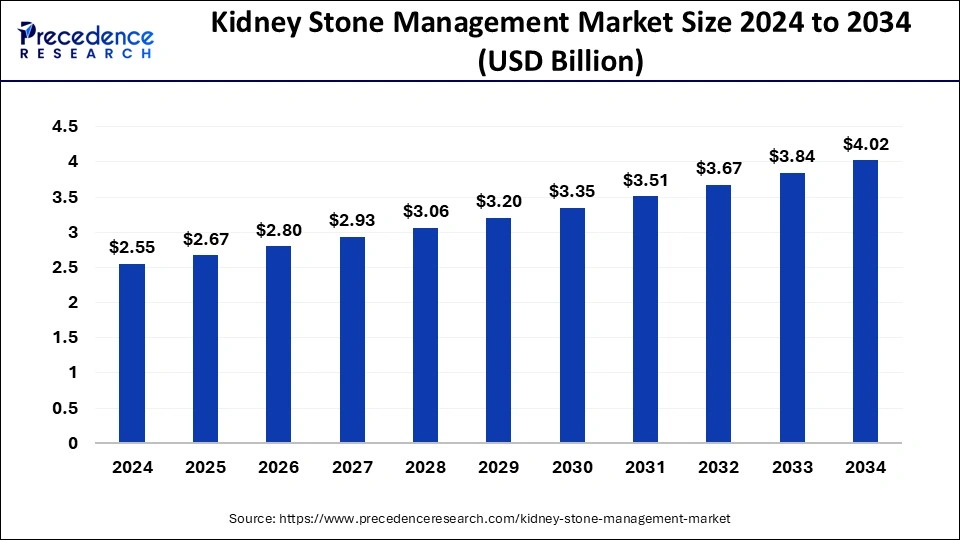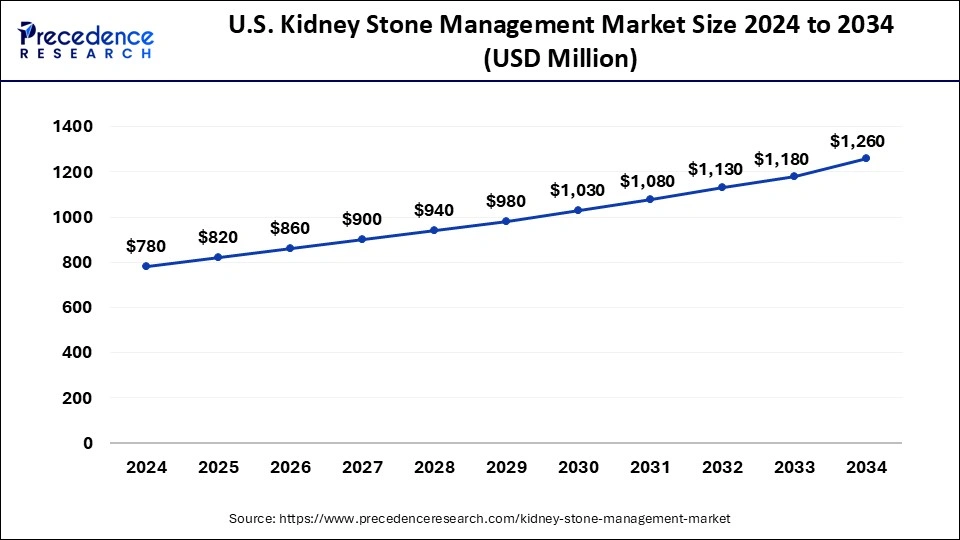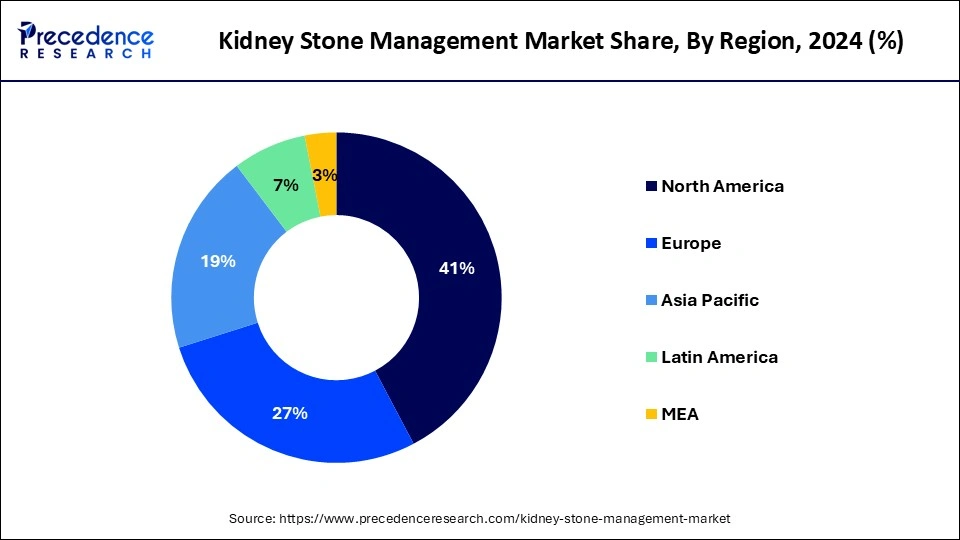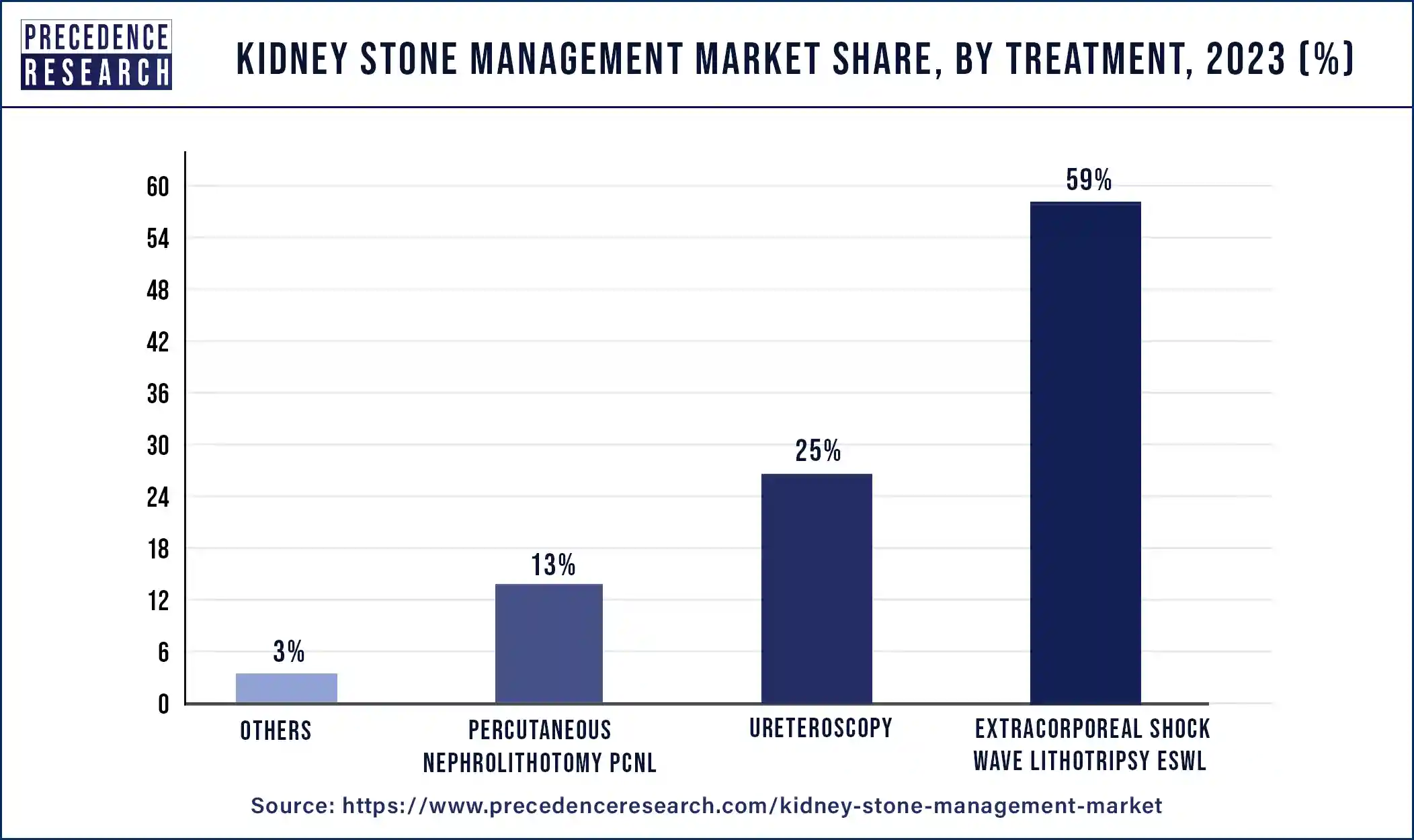List of Contents
Kidney Stone Management Market Size and Forecast 2025 to 2034
The global kidney stone management market size accounted at USD 2.55 billion in 2024 and is predicted to increase from USD 2.67 billion in 2025 to approximately USD 4.02 billion by 2034, expanding at a CAGR of 4.65% from 2025 to 2034. Rising cases of kidney stones worldwide due to the modern sedentary lifestyle and excessive intake of minerals and salt-based diet among the population are major drivers of the market globally.

Kidney Stone Management Market Key Takeaways
- The global kidney stone management market was valued at USD 2.55 billion in 2024.
- It is projected to reach USD 4.02 billion by 2034.
- The kidney stone management market is expected to grow at a CAGR of 4.65% from 2025 to 2034.
- North America dominated the kidney stone management market globally in the previous year of 2024, and it is poised to hold its position during the forecast period.
- Asia Pacific is an expanding market and is projected to hold a significant market share in 2024.
- Based on stone type, the calcium oxalate segment held the largest share in the market in 2024.
- Based on diagnostics, the ultrasound segment held a significant share of the market in 2024.
- Based on treatment, the extracorporeal shock wave lithotripsy- ESWL segment held the largest share in 2024 and dominated the kidney stone management market globally.
- Based on end use, the hospitals segment held the largest market share and dominated the market.
- Based on end use, the specialty clinics segment is expected to experience the highest growth rate over the forecast period.
- By type of stone, the calcium phosphate segment is anticipated to show considerable growth in the market over the forecast period.
- By diagnostics method, the computed tomography segment is anticipated to show considerable growth in the market over the forecast period.
- By treatment, the ureteroscopy segment is anticipated to show considerable growth in the market over the forecast period.
How is AI Integration Transforming the Kidney Stone Management Market?
AI can transform kidney stone management, and this is enhancing patient outcomes, diagnosis, and planning of treatment. The AI algorithms can predict the composition and size of the stones, which helps urologists to choose the most efficient method of treatment for the cases, including lithotripsy. From predictive analytics, individualized treatment plans have become more precise by the examination of patient history, the probability of the disease recurring, and how the patient responds to treatments.
Furthermore, surgical robotics can encompass AI-based solutions on robots, which enhance the precision of minimal interventions and constrain the recuperation phases, as well as reduction of surgery complications. Remote monitoring and AI-based decision support post-treatment follow-up. The application of AI is resulting in a more effective, efficient, and patient-centered management of kidney stones and in the reduction of health care costs, and the growth of clinical outcomes.
U.S. Kidney Stone Management Market Size and Growth 2025 to 2034
The U.S. kidney stone management market size was evaluated at USD 780 million in 2024 and is projected to be worth around USD 1,020 million by 2034, growing at a CAGR of 4.91% from 2025 to 2034.

North America dominated the kidney stone management market globally in the previous year of 2024.The region is popular for its novel technologies and research centers with world-class medical facilities, institutions, and effective procedures to remove kidney stones with minimal invasion in the human system, leading to lesser damage of healthy cells in the body that would not be achievable otherwise by conventional surgery practices by professionals. Country-wise, unites states has an exceptionally advanced healthcare system facilitated by a robust infrastructure.
The US has pharmaceutical companies that are highly engaging in the research and development of cutting-edge technologies that can be integrated with the healthcare system to reduce the possible improved diagnostic tools effectiveness and outcome of kidney stone removal procedures can be enhanced. Consequently, healthcare providers acknowledge this rising demand and have started offering a wide range of customized services with advanced treatments, which is attracting patients to the North American healthcare system and further driving the growth of the kidney stone management market on a global level.

Asia Pacific is an expanding market, and it is projected to hold the largest share of the kidney stone management market, with an estimated revenue share of 36% by the end of 2034. The geriatric population and age-related health concerns, including kidney-related dysfunctionalities, are prominent drivers of the Asia Pacific market. Such a rising trend increases the demand for effective management strategies fabricated with the particular needs of individuals suffering from kidney diseases, which could be fatal in the long run.
Technological advancements play an essential role in driving the Asian Pacific market. The region has numerous innovative technologies that offer precise and effective treatment. The integration of robotic assistance with advanced tools is crucial to managing kidney stone procedures and enhancing the capabilities of the healthcare sector.
- According to the WHO, the total geriatric population will be 20% more in Asia Pacific by the end of 2050 as demographic shifts occur.
China Kidney Stone Management Market Trend
China is estimated to grow at the fastest CAGR during the forecast period, led by the inventions and innovations in healthcare, support policies, and an increase in the awareness of the populace. The government of China is engaging in healthcare infrastructure development and other health promotion programs, such as the early detection and successful management of chronic diseases, such as kidney stones. Disease burden prevention efforts like financing of clinical trials, health awareness of prevention efforts, and dietary and healthy hydration habits implementation, are reducing the burden. Due to the fast urbanization and lifestyle changes, there is an elevated use of sodium-heavy, low-liquid diets that increases the development rate of kidney stones in the nation.
Europe Kidney Stone Management Market Trend
The European kidney stone management market is expected to account for a substantial market share in 2024, owing to the presence of strong health care infrastructure, a rise in awareness, and the use of the latest medical technologies. There is an increasing trend of kidney stones across the region through the consequences of aging, nutritional choices, and lack of exercise. Moreover, non-contrast CTs and a personalized treatment plan are also improving the effectiveness and accuracy of kidney stone management because of increased imaging technologies. Market growth is also being facilitated by government funding of kidney health and early screening through government-sponsored health campaigns all over Europe.
In the U.K., the market for kidney stone management is experiencing stagnant growth. A great variety of kidney stone treatments are covered by the NHS, including the first visits and imaging, to complex surgical procedures. Further, the digital health and artificial intelligence investments will enhance the level of diagnosis as well as approaches to personalized treatment in the UK. With the trend of lifestyle-related incidences of kidney stone showing an upward trend, the market in the UK is likely to grow further with the help of the continuous support of governments, technological advancements related to minimally invasive technology, and a patient-centered approach in the dynamic healthcare setting.
Market Overview
The kidney stone management market is witnessing significant growth due to the rising prevalence of kidney stones worldwide. A kidney stone is also known as renal calculus.it is a complex, crystalline mineral material formed within the kidney or urinary tract. These stones can cause severe pain and discomfort, which has led to an increased demand for effective and innovative solutions for kidney stone management.
Despite the availability of advanced treatment options, the high costs associated with kidney stone management procedures can be a highly impeding market restraint. The expenses involved in surgeries, hospital stays, and post-operative care can financially burden patients, particularly in developing countries with limited healthcare resources.
The kidney stone management market is driven by factors such as the increasing prevalence of kidney stones, advancements in medical technology, and the aging population. However, high treatment costs and a need for more awareness act as restraints on market growth. Opportunities exist in the demand for non-invasive procedures, the adoption of ESWL, and technological advancements in stone retrieval devices. As the global burden of kidney stones continues to rise, the market is poised for further growth and innovation in the coming years.
Kidney Stone Management Market Growth Factors
- Increasing prevalence of kidney stone disease globally due to the sedentary lifestyle.
- The continuous advancements in medical technology, such as minimally invasive procedures, shock wave lithotripsy (SWL), and ureteroscopy, have significantly contributed to the growth of the kidney stone management market.
- A higher intake of minerals and salts causes a higher recurrence rate of kidney stones, proliferating the market.
- Technical advancement in treatments like Extracorporeal shock wave lithotripsy- ESWL is propelling the growth of the market.
- Higher inclination of patients for minimally invasive surgeries led to an increase in demand for advanced treatments.
- Rising awareness about kidney health worldwide is fuelling the market's growth at a higher rate.
- The growth in the market can be attributed to the adoption of kidney ultrasound by several medical professionals and radiologists.
Market Scope
| Report Coverage | Details |
| Growth Rate from 2025 to 2034 | CAGR of 4.65% |
| Market Size in 2025 | USD 2.67 Billion |
| Market Size by 2034 | USD 4.02 Billion |
| Largest Market | North America |
| Base Year | 2024 |
| Forecast Period | 2025 to 2034 |
| Segments Covered | Type of Stone, Diagnostics Method, Treatment, and End-use |
| Regions Covered | North America, Europe, Asia-Pacific, Latin America, and Middle East & Africa |
Market Dynamics
Driver
Increasing prevalence of kidney stone
The primary driver for the kidney stone management market is the growing prevalence of kidney stones globally. Factors such as a sedentary lifestyle, poor diet choices, and increased obesity rates have contributed to the rise in kidney stone cases. The increasing number of patients seeking medical intervention to manage kidney stones has created a growing market for innovative and efficient treatment options.
The global aging population is another significant reason for the kidney stone management market. Older individuals are more susceptible to developing kidney stones due to age-related kidney and urinary system changes. The increasing number of elderly individuals worldwide is expected to drive the demand for kidney stone management solutions.
Restraint
Lack of awareness among the population
A major restraint for the kidney stone management market is the need for more awareness about kidney stones and their management. Many individuals may need to be aware of the symptoms, risk factors, and available treatment options. This leads to delayed diagnosis and treatment, affecting market growth. Educational campaigns and awareness programs are essential to overcome this restraint and improve patient outcomes.
Opportunity
Growing demand for non-invasive medical procedures
There is a growing demand for non-invasive or minimally invasive procedures for kidney stone management. These procedures offer several advantages over traditional open surgeries, such as reduced pain, shorter hospital stays, and faster recovery times. Innovative techniques like laser lithotripsy, percutaneous nephrolithotomy (PCNL), and robotic-assisted surgeries provide immense opportunities for market growth.
ESWL is a well-established method for kidney stone management and is widely adopted globally. This non-invasive procedure uses shock waves to break down kidney stones into smaller pieces, making them easier to pass through urine. The increasing adoption of ESWL, especially in developing countries, presents significant growth opportunities for the kidney stone management market.
Type of Stone Insights
The calcium phosphate segment is expected to grow at a significant CAGR over the forecast period. They are frequently found in the alkaline urine and are stimulated by such maladies as hyperparathyroidism, renal tubular acidosis, and even some urinary infections. As diagnostic techniques are improved, the distinction between the types of stones can be made more accurately by healthcare professionals, therefore leading to a more precise treatment scheme.
Calcium phosphate stones are generally treated with foods, medication, and in severe cases, surgery. Moreover, due to the increasing popularity of preventative treatments and less-invasive procedures that are adapted to the type of stones, the demand for calcium phosphate stone management solutions grows.
Diagnostics Method Insights
The computed tomography segment is expected to grow substantially in the kidney stone management market. CT scans have better imaging resolution, which allows medical professionals to identify the small and large kidney stones of diverse composition. The CT scans are quick, and they are often accomplished within a few minutes is one of the greatest strengths of CT scans as they may rely on the emergency setting.
CT imaging can also aid in determining the location, density, and quantity of stones, which is imperative in determining the most suitable mode of treatment, whether it is medical management, lithotripsy, or surgery. Moreover, rising investments and approvals of new sophisticated CT systems will augment their accessibility and uptake in hospitals and clinics, boosting the businesses of this segment.
Treatment Insights
The ureteroscopy segment is expected to grow substantially in the kidney stone management market. Ureteroscopy consists of the insertion of a thin and flexible scope into the urinary tract to identify and treat urinary stones using precision and effectiveness in locating and treating even small and difficult-to-diagnose stones invisible in conventional X-ray machines. The growing popularity of ureteroscopy is also prompted by the increase in the demand for short-term recovery, few complications, quick and clean procedures with no external incisions.

Moreover, this treatment has become more readily available in different healthcare facilities with the growing availability of sophisticated ureteroscopes and laser lithotripsy equipment. The ureteroscopy costs less and has better success rates, and the changing clinical guidelines support the procedure in treating different types of kidney stones.
End-use Insights
The hospitals segment held the largest market share and dominated the kidney stone management market. The market is divided by end-users, including hospitals, specialty clinics, ambulatory surgical centers, and others. This segment is witnessing a rise in kidney stone patients and hospitals adopting advanced technology. Hospitals provide satisfactory reimbursement to patients. That is also another major driver of growth in this segment.
After the hospital segment, the specialty clinics segment is expected to experience the highest growth rate over the forecast period. They are currently the fastest-growing segment in the global market, followed by the hospitals segment. The specialty clinics segment will see a rise in skilled surgeons and favorable reimbursement policies available for patients.
Recent Developments
- In November 2024, Nissha and EndoTheia introduced FlexStone Basket, the FlexStone Basket dispenses the best control and precision in kidney stone removal. This unique technology helps surgeons to find their way through complicated anatomies with much ease, which results in better patient outcomes and less complexity of a procedure.
- In April 2024, Cook Medical unveiled its new Ascend single-use flexible ureteroscope in Canada and the U.S. This is a move that is expected to advance its regional coverage through diversification of products.
In February 2023, Boston Scientific Corporation was approved by the FDA to use its new digital flexible ureteroscope system, LithoVue Elite. Source(https://nissha360.com), Source- (https://www.cookmedical.com), Source- (https://www.prnewswire.com)
Kidney Stone Management Market Companies
- Cook Medical Inc. (US)
- Boston Scientific Corporation (U.S.)
- Olympus Corp. (Japan)
- C.R. Bard Inc. (U.S.)
- Storz Medical AG (Switzerland)
- Richard Wolf GmbH (Germany)
- Lumenis (Israel)
- EDAP TMS (France)
- DirexGroup (Germany)
- Elmed Electronics & Medical Industry & Trade Inc. (Turkey)
- Medi spec Ltd. (U.S.)
- Convergent Laser Technologies (U.S.)
- E.M.S. Electro Medical Systems S.A. (Switzerland)
- Dornier MedTech GmbH (Germany)
- Stryker Corp. (U.S.)
- Olympus Corp. (Japan)
Segments Covered in the Report
By Type of Stone
- Calcium oxalate
- Calcium phosphate
- Uric acid
- Cysteine
- struvite
By Diagnostics Method
- Abdominal X-Ray
- Computed Tomography
- Ultrasound
- Abdominal MRI
- Intravenous Pyelography
- Others
By Treatment
- Extracorporeal Shock Wave Lithotripsy ESWL
- Ureteroscopy
- Percutaneous Nephrolithotomy PCNL
- Others
By End-use
- Hospitals
- Specialty Clinics
- Ambulatory Surgical Centres
- Other
By Geography
- North America
- Europe
- Asia-Pacific
- Latin America
- Middle East and Africa
For inquiries regarding discounts, bulk purchases, or customization requests, please contact us at sales@precedenceresearch.com
Frequently Asked Questions
Ask For Sample
No cookie-cutter, only authentic analysis – take the 1st step to become a Precedence Research client